Vines are an interesting as they can be found everywhere in the landscape, including growing on trees. Vines that grow on trees are a unique and fascinating aspect of nature.
These plants, also known as lianas, are characterized by their ability to cling to and climb up the trunks and branches of trees in order to reach the sunlight they need to survive.
While some people think of vines as nothing more than weeds, these plants have their useful roles to the ecosystem. For example, they can provide food and shelter for wildlife, help prevent soil erosion, and even improve air quality by absorbing pollutants.
They can also even be used for decorative and other practical purposes such as covering fences or walls, or training to climb and decorate arbors or trellises.
There are many different types of vines that can be found growing on trees. Some are evergreen and can provide year-round coverage for trees.
Others produce beautiful, brightly colored flowers that attract pollinators whereas others are considered invasive species and can quickly take over and destroy the ecological beauty of an area if not controlled.
One of the most interesting aspects of vines that grow on trees is the way they are able to cling to and climb their host trees. Some vines have tendrils that can wrap around branches and trunks whereas others have small aerial roots that can grip onto rough surfaces.
More importantly, many vines have evolved to produce chemicals that can inhibit the growth of other plants growing around them, allowing them to better compete for sunlight and resources.
List of vines that grow on trees
- Love vine (Cuscuta reflexa)
- Smilax vine or greenbrier (Smilax rotundifolia)
- Virginia Creeper (Parthenocissus quinquefolia)
- Climbing Hydrangea (Hydrangea anomala)
- Trumpet Vine (Campsis radicans)
- Japanese Honeysuckle (Lonicera japonica)
- Boston Ivy (Parthenocissus tricuspidata)
- Wisteria (Wisteria ssp)
- Dutchman’s Pipe (Aristolochia macrophylla)
- Red Passionflower (Passiflora quadrangularis)
- Grapevine (Vitis)
- Clematis (Clematis ssp)
- Star Jasmine (Trachelospermum jasminoides)
- Kudzu (Pueraria montana)
Characteristics of Vines That Grow on Trees
- Most of them have Tendrils: thin, flexible extensions used to grasp onto the tree trunk or branches.
- They have aerial roots: roots that grow above the ground to help the vine cling to the tree.
- They have thick, woody stems that can support the weight of the vine as it grows up the tree.
- They have climbing mechanisms which includes specialized structures such as hooks or prickles that help the vine climb.
- Have leaves that are smaller and more leathery than other types of vines, to help reduce water loss and survive in the shaded environment of the forest canopy.
- Most of them love twining: the ability to wrap around the host tree trunk or branches.
- They are Photosynthetic: ability to produce its own food through photosynthesis.
- Have ability to produce flowers and fruits.
- They can deciduous or evergreen: depending on the species, the vine may lose its leaves annually or keep them throughout the year.
- They show parasitic tendencies: ability to extract resources from the host tree, potentially causing harm to the host tree.
Description of the Plants And Their Impact
Love vine (dodder)

Cuscuta reflexa, also known as dodder or love vine, is a parasitic plant that belongs to the genus Cuscuta. It is a twining vine that attaches itself to other plants, using haustoria (small, root-like structures) to penetrate the host plant’s vascular system and extract nutrients.
The plant does not have any chlorophyll, so it cannot photosynthesize and produce its own food. Instead, it relies on the host plant for its survival.
Cuscuta reflexa is native to tropical and subtropical regions of the world, but it can also be found in other areas as an introduced species. The plant’s stem is thin, wiry, and often orange or yellow in color. The leaves are reduced to small scales or are absent altogether.
This plant is considered a weed and a pest in many areas, as it can infest and damage crops, orchards, and gardens. It can also reduce the growth and vigor of the host plant, and in some cases, it can kill the host.
Smilax vine
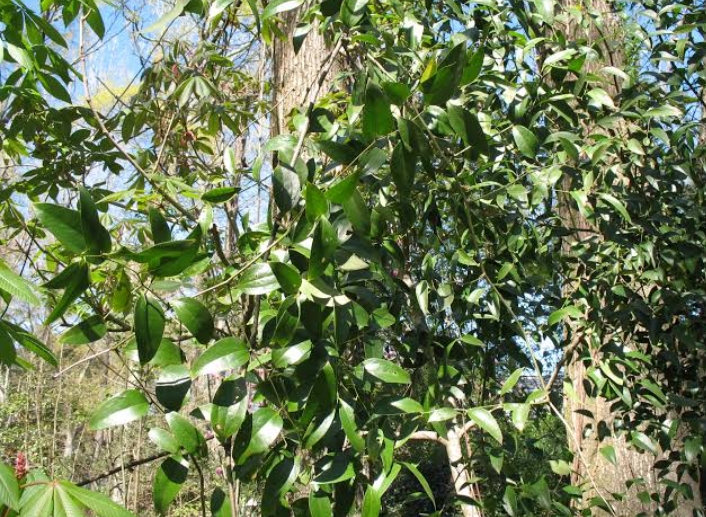
Smilax is a genus of perennial climbing flowering plants, many of which are woody and/or thorny and are commonly found growing on trees. These plants usually have large, glossy leaves and small green or white flowers, which are followed by berries that can be black or blue in color.
Smilax species are native to many parts of the world and are widely cultivated as ornamental plants. They are also known as greenbriers, catbriers, or simply briers.
Smilax species will grow vigorously to reach impressive heights, depending on the species and the size of the host tree. Some species can grow beyond 35 feet tall, while others may only reach a few feet.
They can also spread out wide by producing many lateral branches, providing a dense foliage. Some species of Smilax can be invasive in certain regions, and can cause damage to native vegetation by smothering or killing smaller trees and shrubs.
Virginia creeper
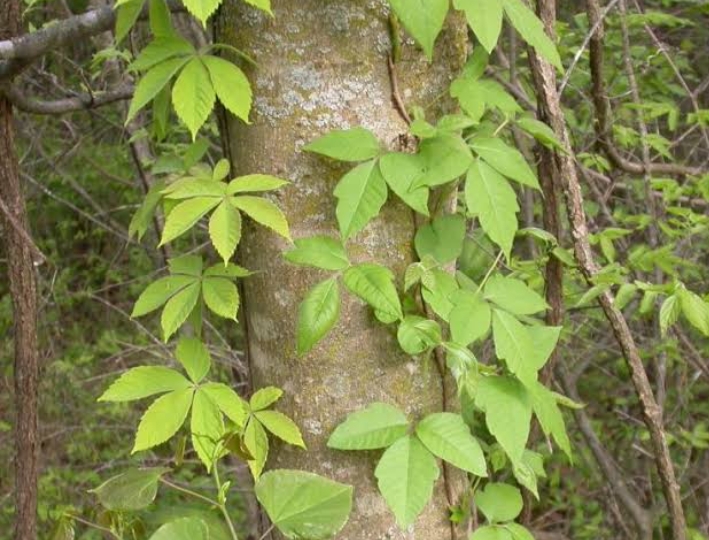
Also known as woodbine, Virginia creeper is native to eastern North America. This vigorously or rambunctious growing woody vine has ability to climb trees and other structures using small tendrils with adhesive pads.
The vine can grow up to 50 feet in length and produces clusters of small, greenish-white flowers in the spring, followed by blue-black berries in the fall.
The leaves are also distinctive as they have a palmate shape and are lobed. The leaflets are approximately between 2 and 3 inches long and have a glossy, dark green color. The leaves change color in the fall to a brilliant red.
This vine can also smother the tree by blocking sunlight from reaching its leaves and branches, which can inhibit growth and lead to the death of the tree. Moreover, the vine’s leaves can trap moisture around the tree’s trunk and this can result to emergence of diseases.
Climbing Hydrangea
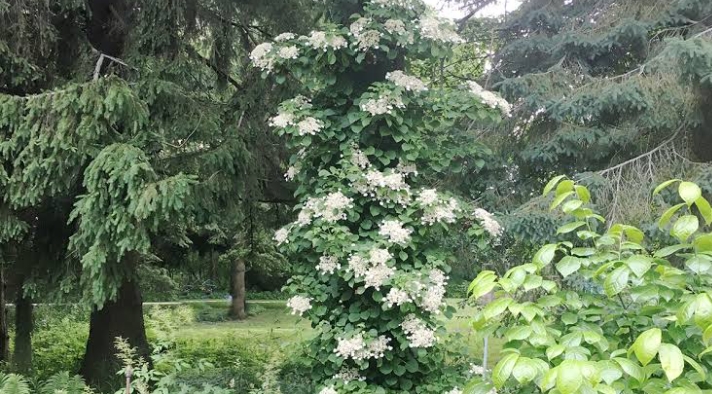
Climbing Hydrangea is a deciduous climbing vine that is native to China, Japan and Korea. This is not a twining vine that wraps around supports, or a tendril-clasping vine, but a true clinging vine that can reach unpruned heights exceeding 40 feet.
The plant has aerial roots that grab hold of rough surfaces, such as brick, wood and other plants, and fastens securely. It is a slow-growing plant, but can be pruned to control its size and shape.
It features large, showy flowers that bloom in late spring to early summer. In many plants the flowers are white, but they still can also be white with shades of pink depending on the soil pH.
A full-grown climbing hydrangea vine may be up to 75 feet tall and it is covered with attractive, heart-shaped leaves throughout spring and summer. The leaves fall in autumn, revealing a showy, reddish-brown, exfoliating bark.
When growing around a tree, it can damage or kill the tree especially if it becomes too heavy or overgrown. The vine can also smother the tree by blocking sunlight from reaching its leaves and branches.
Trumpet Vine
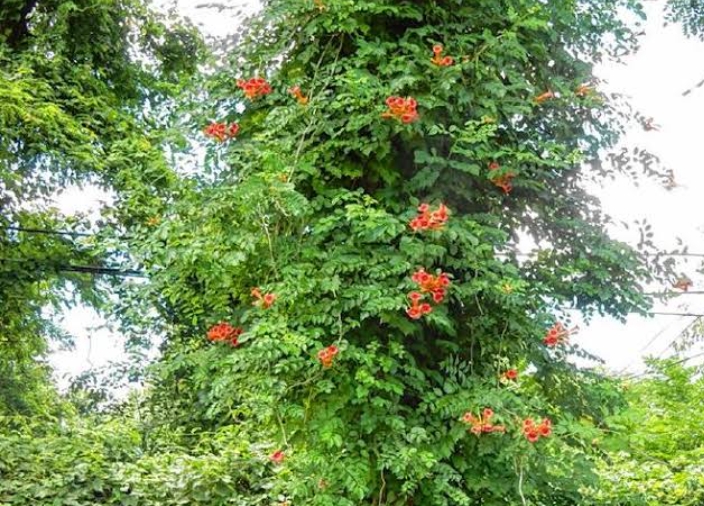
Trumpet vine also called trumpet creeper, is beautiful and fast-growing, deciduous or semi-evergreen vine that is native to the southeastern United States.
It is a vigorous climber, reaching 25 to 40 feet high and 5 to 10 feet wide with large showy orange or red trumpet-shaped flowers that bloom in late summer and fall.
Trumpet vine is a vigorous grower that can quickly cover large areas outcompeting native plants for resources if not kept in check. The plant climbs by way of its holdfasts, or aerial rootlets to cling to surfaces, which can damage the bark of trees and shrubs, potentially leading to infection and death.
According to accounts of very many people, it is always difficult to remove or kill this plant once established. Trumpet vine can also cause damage to tree trunks and branches by wrapping tightly around them and breaking them under its own weight.
Also Read: Shrubs For Front of House
Japanese Honeysuckle
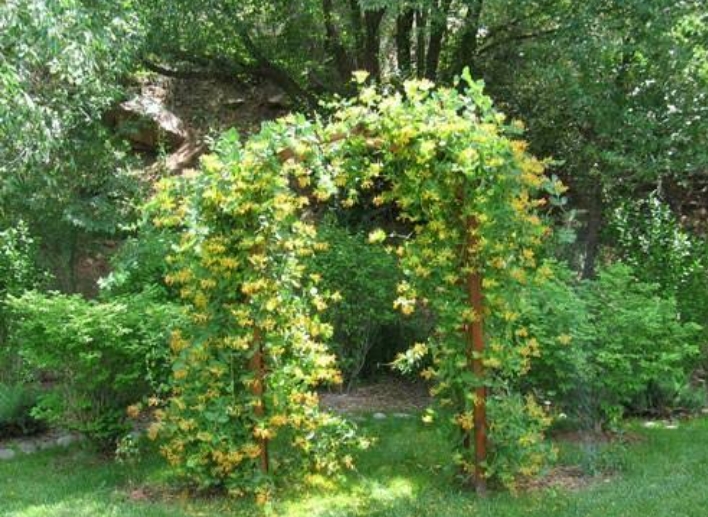
Japanese honeysuckle is a species of honeysuckle native to eastern Asia, including China, Japan, and Korea. It is a climbing vine that can grow up to 30 feet in length. It is an invasive species in many parts of the world, including the United States where it can outcompete native vegetation and harm ecosystems.
For sure, it is considered a serious invasive species and control efforts are often necessary to prevent it from spreading. This vine is known for its fragrant, white or yellow flowers that bloom in the spring and summer.
The impact of growing Japanese honeysuckle on trees can be significant. As a climbing vine, the plant can quickly cover and shade out the canopy of the tree, preventing sunlight from reaching the tree’s leaves. This can inhibit photosynthesis and ultimately harm the tree’s health and growth.
The vine’s roots can also encircle the trunk of the tree, causing mechanical damage and making the tree more susceptible to falling.
Boston Ivy
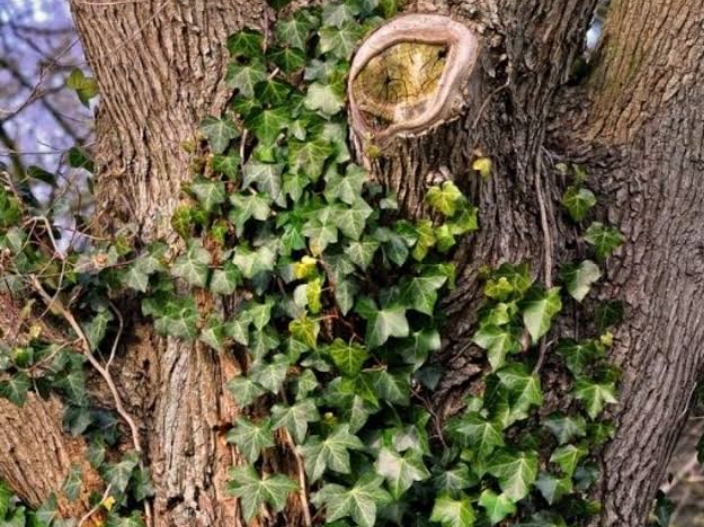
Boston Ivy is a species of ivy native to eastern Asia, including China, Korea, and Japan. It is a climbing vine that can grow up to 50 feet in length. New leaves open to reddish-bronze and mature to dense, green foliage. In fall the overlapping leaves turn to brilliant red, scarlet or purple-wine in color.
The plant produces blue-black berries that persist throughout winter. The leaves are usually three-lobed and the stem will always have small, adhesive pads called holdfasts that allow the vine to cling to surfaces of walls and trees.
The plant is deciduous and will lose its leaves in fall and winter, but it is a vigorous grower and can quickly cover a large area. However, like Japanese honeysuckle, Boston Ivy can also become invasive and cause damage to buildings or trees if not controlled properly.
The weight of the vine also can be a problem if the vine gets too heavy, it can break branches or even bring down the whole tree.
Wisteria
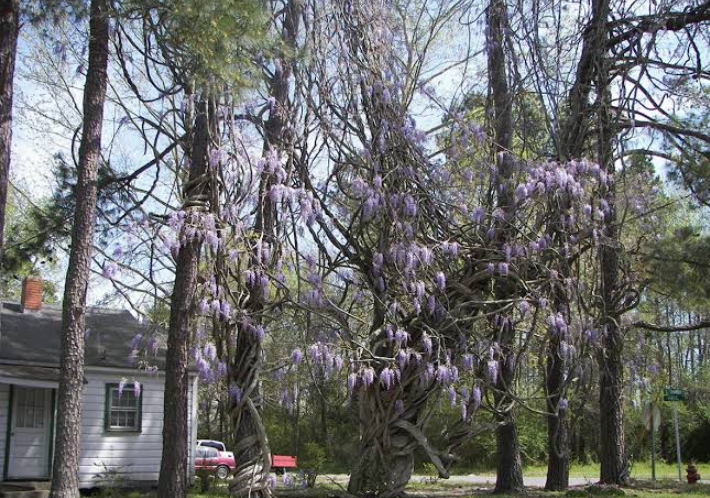
Wisteria is a species of flowering plant native to Japan, China, and the eastern United States. It is a climbing vine that can grow to great lengths, often reaching the tops of tall trees or the sides of buildings.
Wisteria is characterized by large, pendulous clusters of fragrant flowers, which can be purple, blue, pink, or white, depending on the variety.
It’s probably not a good idea to allow wisteria to climb up into a tree. Unlike climbing vines such as hydrangea, which tend to grow straight up the tree without encircling the trunk and branches, wisteria vines tend to wrap around whatever they climb.
The vines produce thick foliage that can shade out the tree, causing it to drop needles prematurely, weakening the tree. The weight of all of those ever-thickening vines high up in the tree, along with the wisteria’s summer foliage, greatly increases the chance of the tree coming down in a windstorm.
Dutchman’s Pipe
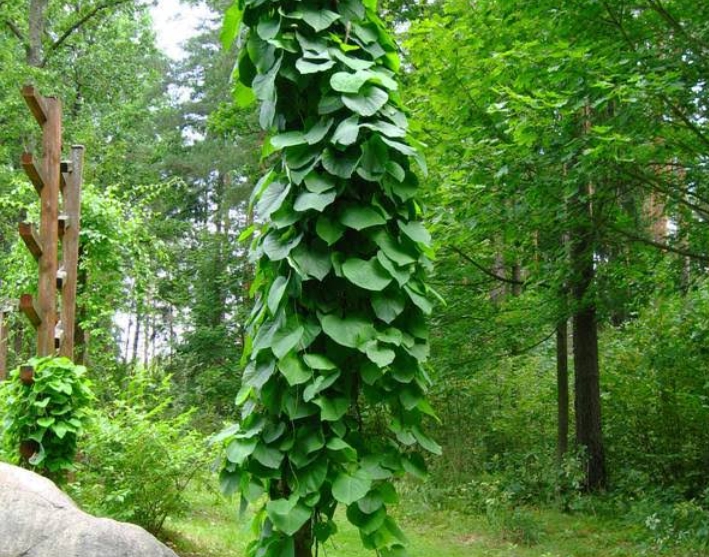
The Dutchman’s Pipe, also known as Aristolochia durior, is a species of perennial vine native to the eastern United States and is commonly found in woodlands, along stream banks, and in other moist, shaded areas.
The Dutchman’s Pipe is a fast-growing vine and can grow to heights beyond heights 30 feet. It is generally a strong climber that effortlessly climbs trees and shrubs. The plant is widely acknowledged for its hardiness and tolerance of a wide range of soils and climates.
The plant has large, heart-shaped leaves and produces unusual, pipe-shaped flowers that are brownish-purple on the outside and white on the inside. The flowers can vary between 2-3 inches long and are produced in the spring and summer.
The vine can provide visual interest and add a unique aesthetic to the tree when growing on trees. It can also be harmful to the tree if not properly managed. The vine can grow aggressively and can quickly overtake the tree, blocking sunlight and suffocating the tree by depriving it of air and nutrients.
Also Read: Types of Willow Trees
Red Passionflower
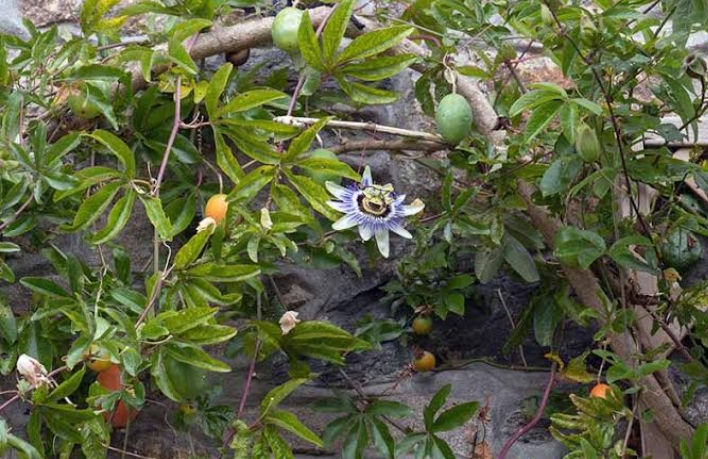
The red passionflower also referred as giant granadilla plant is a fast-growing vine, with a woody base. It is a perennial climber native to tropical Americas, Southeast Asia and Australia.
At maturity, it can climb up to 50 feet tall. The flowers are nearly identical to the frilly, firework-shaped blooms of other passion vines, but double the size. Flowers form aromatic, melon-like fruit with blushing pink or white flesh.
The plant’s leaves are opposite, oval-shaped, and dark green in color. This plant is extremely vigorous and can become invasive and begin to outcompete native vegetation and harm ecosystems.
When growing around or on trees, the vine can also damage the tree’s bark, causing it to rot or become diseased. Furthermore, the root systems of the vine and tree can compete for water and nutrients, which can cause stress to the tree and reduce its growth and health.
Wild Grapevine
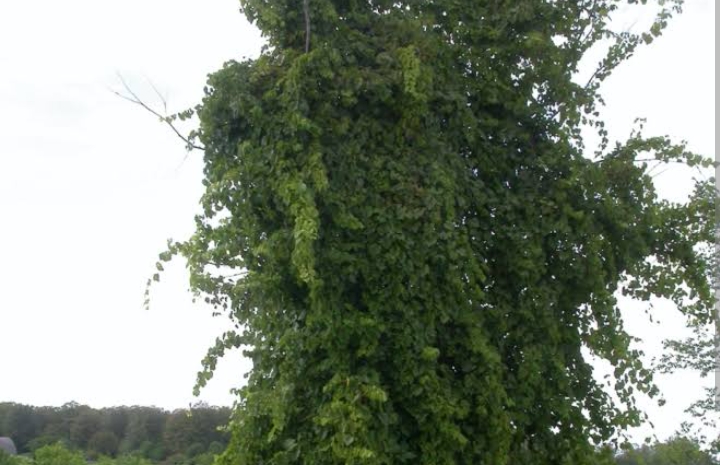
The grapevine is a stem-tendril climbing plant that grows upward with vigorous overhanging (cascading) growth. As a woody perennial that can grow to be very large, with some varieties reaching up to 100 feet in length.
The leaves of the grapevine are green and lobed, and the plant produces clusters of small, green flowers that give way to the grapes. Wild grapevines can grow vigorously around the tree and can climb and encircle the whole tree’s crown.
If a grapevine is allowed to grow on a tree, it can result in a number of problems. The most obvious effect is the competition for resources, as the grapevine will take away sunlight, water, and nutrients from the tree. This can eventually cause the tree to become stunted or even die.
The grapevine’s weight and size can also put a lot of stress on the tree, potentially breaking branches or causing the tree to lean. Grapevines can live for 50 to 100 years or more. Some of California’s oldest vineyards contain grapevines dating back to the 1880s.
Clematis
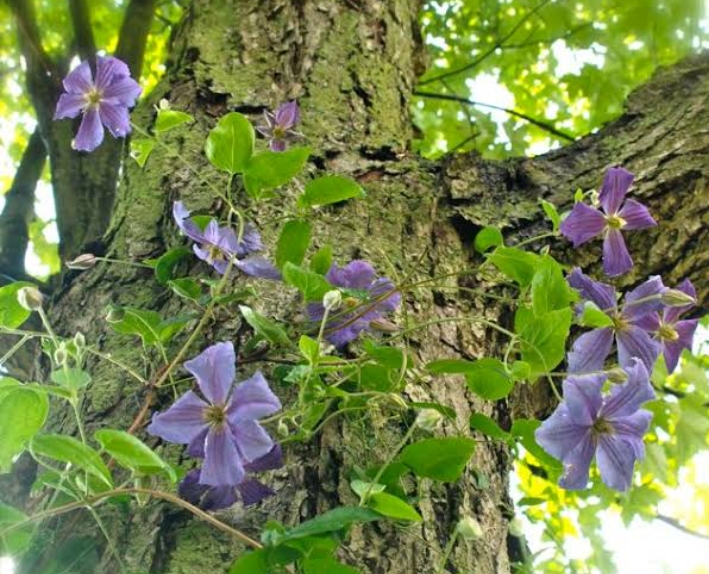
Though mostly deciduous vines, the Clematis genus includes evergreens and shrubs. They are native to many regions of the world, including Europe, Asia, and North America.
These perennial plants have large flowers that come in a variety of colors, including pink, purple, red, white, and yellow. They can grow to be quite large, with some varieties reaching heights of 30 feet or more and can grow on fences or trees.
When grown on trees, clematis plants will attach themselves to the trunk and branches by wrapping their wrists around small twigs, instead of growing roots that attach like ivy.
Clematis growing on tree can lead to is the over shading of the tree which can lead to slow growth and root system can also damage the tree’s roots, making it more susceptible to disease or pests.
Also Read: Sycamore Trees: Types and Their Identifying Features
Star Jasmine
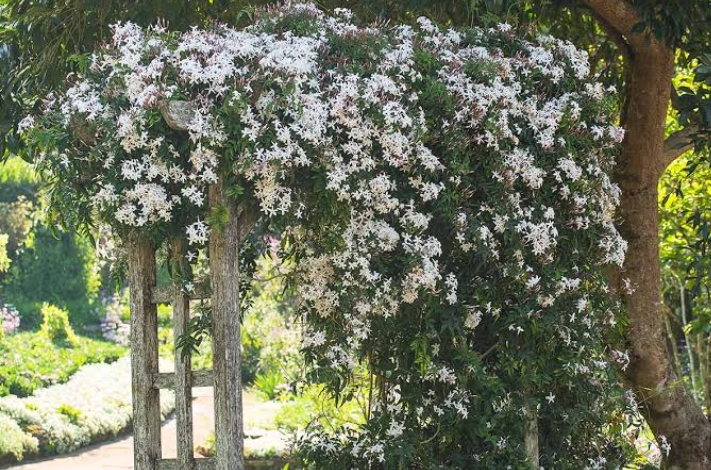
Star Jasmine also called confederate jasmineis a climbing vine that is native to East Asia, including Japan, China, and Korea. The plant is not true jasmine plants, but they do look similar.
This is a versatile plant that can be grown in a variety of ways: as a ground cover, a climbing vine or a container plant. Star jasmine grows its root system with runners. This means that as the plant expands, roots form wherever the plant touches the ground.
The evergreen foliage is dark green and glossy, and it bears fragrant white flowers during the spring and summer. The vines grow quickly with vines that grow up to 20 feet long and a mature height of only 2 feet tall.
This plant can be trained to grow up and over the branches of trees, creating a unique and striking visual effect. Though when growing on fences or trees, it overtakes the host tree and cause damage to the tree’s structure and health.
Kudzu
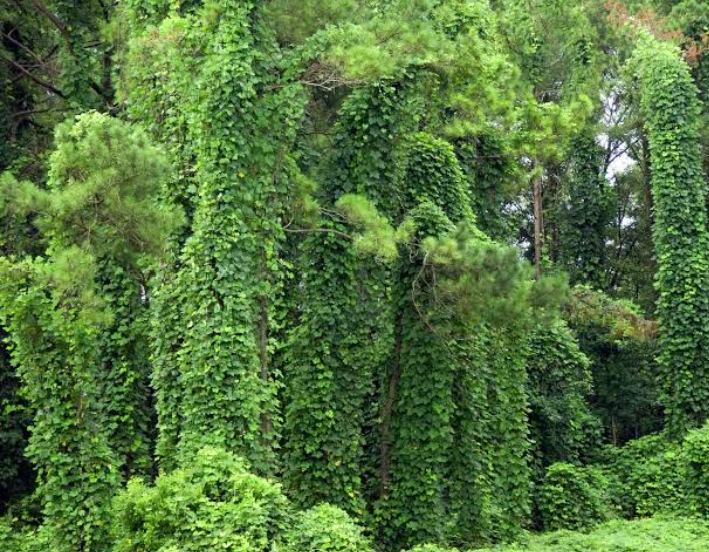
Kadzu is an aggressive and highly invasive vine native to Japan and China and was introduced to the United States in the late 19th century. The plant is classified as a noxious weed by the U.S. government and is illegal to grow in many states.
It is known for its fast growth and ability to spread quickly, which has led to it being considered an invasive species in many parts of the country. The plant can grow up to 60 feet in a single growing season and can cover large areas of land, including trees and buildings.
The leaves of the kudzu plant are large and triangular and the flowers are purple and fragrant. The root system is deep and extensive, making it difficult to control once it becomes established.
Kudzu is also toxic to livestock and can cause health problems if consumed in large quantities. Trees that are affected by kudzu can also become more susceptible to pests and diseases, as the thick foliage provides an ideal environment for insects and fungal growth.